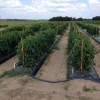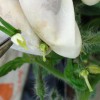 Salmonella and other human pathogens can contaminate produce at any stage from “farm to fork.” If we can better understand how production practices may make crops more or less susceptible to human pathogens we may be able to significantly reduce the number and severity of the produce-associated outbreaks. This 3-page fact sheet provides up-to-date information about tomato production practices and their relationships with Salmonella. Written by Massimiliano Marvasi, George Hochmuth, and Max Teplitski, and published by the UF Department of Soil and Water Science, December 2014. (Photo: Max Teplitski, UF/IFAS)
Salmonella and other human pathogens can contaminate produce at any stage from “farm to fork.” If we can better understand how production practices may make crops more or less susceptible to human pathogens we may be able to significantly reduce the number and severity of the produce-associated outbreaks. This 3-page fact sheet provides up-to-date information about tomato production practices and their relationships with Salmonella. Written by Massimiliano Marvasi, George Hochmuth, and Max Teplitski, and published by the UF Department of Soil and Water Science, December 2014. (Photo: Max Teplitski, UF/IFAS)
http://edis.ifas.ufl.edu/ss628
Tag: Cultural Practices for Tomato
Hand Pollination of Tomato for Breeding and Seed Production
 Hand pollination is a technique that is used for breeding new tomato varieties with desirable characteristics such as plant vigor, disease resistance, and uniform fruit quality and plant growth; since tomatoes have complete flowers and are self-pollinated, it usually is unnecessary to hand pollinate the flowers for fruit production. This 4-page guide illustrates selection and emasculation of flowers from the plant receiving pollen, pollen collection and drying, and pollination of the stigma. Written by Monica Ozores-Hampton, and published by the UF Department of Horticultural Sciences, August 2014. (Photo credit: Monica Ozores-Hampton)
Hand pollination is a technique that is used for breeding new tomato varieties with desirable characteristics such as plant vigor, disease resistance, and uniform fruit quality and plant growth; since tomatoes have complete flowers and are self-pollinated, it usually is unnecessary to hand pollinate the flowers for fruit production. This 4-page guide illustrates selection and emasculation of flowers from the plant receiving pollen, pollen collection and drying, and pollination of the stigma. Written by Monica Ozores-Hampton, and published by the UF Department of Horticultural Sciences, August 2014. (Photo credit: Monica Ozores-Hampton)
http://edis.ifas.ufl.edu/hs1248
Blossom Drop, Reduced Fruit Set, and Post-Pollination Disorders in Tomato (HS1195)
 Blossom drop and reduced fruit set in tomato can seriously impact yields. Growers in Florida routinely experience such problems and inquire about the cause and possible preventative measures to reduce flower loss and improve yields. The problem can be frustrating and difficult to manage in some situations. This 6-page fact sheet was written by Monica Ozores-Hampton, Fnu Kiran, and Gene McAvoy, and published by the UF Department of Horticultural Sciences, July 2012.
Blossom drop and reduced fruit set in tomato can seriously impact yields. Growers in Florida routinely experience such problems and inquire about the cause and possible preventative measures to reduce flower loss and improve yields. The problem can be frustrating and difficult to manage in some situations. This 6-page fact sheet was written by Monica Ozores-Hampton, Fnu Kiran, and Gene McAvoy, and published by the UF Department of Horticultural Sciences, July 2012.
http://edis.ifas.ufl.edu/hs1195
HS1187 Introducción a la Tecnología de Injertos a la Industria de Tomate en la Florida: Beneficios Potenciales y Retos
HS1187, a 7-page illustrated fact sheet by Monica Ozores-Hampton, Xin Zhao, y Miriam Ortez, describes benefits and risks of using grafting technology in tomato production. Includes references. Published by the UF Department of Horticultural Sciences, December 2010.
http://edis.ifas.ufl.edu/hs1187
ENY-678/EP128 A Low Input, Sustainable Production System for Fresh Market Tomatoes
Revised! ENY-678, a 6-page illustrated fact sheet by Jim Rich, Fred Rhoads and Steve Olson, describes a system using disease resistant plant cultivars and sod-based rotation systems to replace or augment chemical alternatives to methyl bromide. Includes references. Published by the UF Department of Entomology and Nematology, May 2008.
http://edis.ifas.ufl.edu/EP128